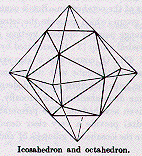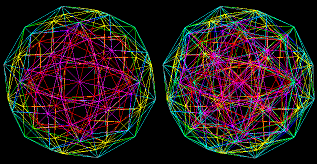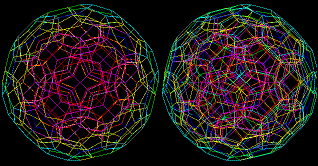
The 4-dimensional HyperDiamond lattice 4HD is made up of one hypercubic checkerboard D4 lattice plus another D4 shifted by a glue vector
(1/2, 1/2, 1/2, 1/2)
in coordinates where the 24 original D4 vertices are (±a ±b) where a and b are distinct elements of {1,i,j,k}.
The result is a tilted hypercubic lattice with 8 links at each vertex: 4 in the future lightcone and 4 in the past lightcone.
The 4HD HyperDiamond lattice next-to-nearest neighbor vertex figure is the D4 lattice nearest neighbor vertex figure, the 24-cell.
Here is the structure of a D4:
The 4-dimensional D4 lattice has quaternionic structure and nearest neighbor light-cone links.
The 4-dimensional D4 or {3,3,4,3} lattice is the natural lattice for 4-dimensional spacetime. Begin with a quaternionic 4-dimensional spacetime R4 = H, where a basis for H is {1,i,j,k}.
The vertices of the D4 lattice are of the form
a01 + a1i + a2j + a3k,
where the ai may be either all integers or four halves of odd integers
(i.e., all ai in Z or all ai in Z + 1/2).
The first shell of the D4 lattice has 24 vertices, or nearest neighbors of the central vertex.
With central vertex 0, the 24 first shell vertices are:
±1, ±i, ±j, ±k, (±1 ±i ±j ±k)/2.
There are also 24 second shell vertices:
(±a ±b), where a,b in {1,i,j,k} and a=/=b.
The 24 vertices of the first shell are the root vector vertices of the Spin(8) Lie algebra D4.
The 48 vertices of the first and second shells together are the root vector vertices of the exceptional Lie algebra F4. (Therefore the lattice can also be called the F4 lattice.)
If the D4 lattice is identified as the lattice of integral quaternions, the 24 first shell vertices are the 24 unit quaternions.
The integral quaternion structure of the D4 lattice is the basis for using it as the natural 4-dimensional spacetime lattice for the theory.
The vertices of the D4 lattice (also called the {3,3,4,3} lattice) have a natural light-cone structure. In quaternionic notation, a general vertex can be considered to be the center of a hypercube with 16 vertices (±1±i±j±k)/2 and the centers ±1, ±i, ±j, ±k of the 8 neighboring hypercubes, or, equivalently, to be the center of a 24-cell (24 vertices).
If any of the 24 neighbor vertices is chosen to be the future timelike direction +1, then
the future light-cone is {(+1±i±j±k)/2} (8 directions),
the spacelike directions are ±i, ±j, and ±k (6 directions),
the past light-cone is {(-1±i±j±k)/2} (8 directions), and
the past timelike direction is -1.
The quaternionic D4 lattice is derived from the E8 octonionic lattices 7E8, 1E8, ... , 6E8 by a projection P: O -} H defined by
P: {1,ie,je,ke ; e,i,j,k}8 -} {1,ie,je,ke ; 1,ie,je,ke}8 -} {1,i,j,k}4 .
P is the identity on {1,ie,je,ke}8 and right-multiplication by -e on {e,i,j,k}8 , followed by a map of the 4-dimensional subspace {1,ie,je,ke}8 of the 8-dimensional octonionic space E8 onto the 4-dimensional quaternionic D4 space {1,i,j,k}4 .
P can be thought of as a rotation of {e,i,j,k}8 by 3pi/2, or -pi/2. Every time pi is applied to {e,i,j,k}8, a phase factor of -e or 3pi/2 is introduced.
Since it not always the case that the image of a vertex in the E8 lattice is always at a vertex in the D4 lattice, it is necessary in such cases to add another step to the projection P that extends the image point (in the same direction) until it hits a vertex that is in the D4 lattice.
P is defined for convenience with respect to the 6E8 lattice, but is effective for the other six as well. The projections under P of all seven of the E8 lattices is the same D4 lattice.
Before dimensional reduction, the 6E8 vertices are, in octonionic notation with a basis for O of {1,i,j,k,e,ie,je,ke}:
6E8: ±1, ±i, ±j, ±k, ±e, ±ie, ±je, ±ke, (±1 ±e ±ie ±k)/2 (±i±j±je±ke)/2 (±1 ±k ±j ±i)/2 3E8, 4E8 (±e±ie±je±ke)/2 (±1 ±i ±je ±ie)/2 (±j±k±e±ke)/2 (±1 ±ie ±ke ±j)/2 5E8, 1E8 (±i±k±e±je)/2 (±1 ±j ±e ±je)/2 7E8, 2E8 (±i±k±ie±ke)/2 (±1 ±je ±k ±ke)/2 (±i±j±e±ie)/2 (±1 ±ke ±i ±e)/2 (±j±k±ie±je)/2
There are 7 different E8 lattices, each defining a 240-vertex 8-dimensional real version of the 4-complex-dimensional Witting polytope.
If you look at the set of all 7 of the E8 lattice sets of 240 vertices:
the 16 vertices +/- er of the 1-element type,
where e0=1, e1=i, e2=j, e3=k, e4=e, e5=ie, e6=je, and e7=ke,
are in all 7 of the sets;
14 x 16 = 224 vertices (+/- eq +/- er +/- es +/- et )/ 2
of the 4-element type (for q,r,s,t distinct indices 0...7)
are in exactly 3 of the sets; and
7 x 8 x 16 = 896 vertices of the 4-element type
are in only 1 of the sets.
Therefore, the 7 types of E8 lattices contain
16 1-element vertices and
224 + 896 = 1120 4-element vertices.
the 7 types of E8 lattices contain all 16 1-element vertices.
ways to choose 4 of 8 and 2^4 = 16 +/- signs of 4 elements,
there are 16 x (8|4) = 16 x 70 = 1120 vertices of the 4-element type,
and the 7 types of E8 lattices contain all 1120 4-element vertices.
Dimensional reduction of spacetime from 8 to 4 dimensions is by a dimensional reduction projection
pi : E8 -} D4
taking the E8 lattice into a D4 lattice.
The E8 lattice can be written in 7 different ways using
octonion coordinates with basis
{ 1 ,e1,e2,e3,e4,e5,e6,e7 }
One way is:
16 vertices:
+/- 1, +/- e1, +/- e2, +/- e3, +/- e4, +/- e5, +/- e6, +/- e7
96 vertices:
(+/- 1 +/- e1 +/- e2 +/- e3) / 2 (+/- 1 +/- e2 +/- e5 +/- e7) / 2 (+/- 1 +/- e2 +/- e4 +/- e6) / 2 (+/- e4 +/- e5 +/- e6 +/- e7) / 2 (+/- e1 +/- e3 +/- e4 +/- e6) / 2 (+/- e1 +/- e3 +/- e5 +/- e7) / 2
128 vertices:
(+/- 1 +/- e3 +/- e4 +/- e7) / 2 (+/- 1 +/- e1 +/- e5 +/- e6) / 2 (+/- 1 +/- e3 +/- e6 +/-e7) / 2 (+/- 1 +/- e1 +/- e4 +/- e7) / 2 (+/- e1 +/- e2 +/- e6 +/- e7) / 2 (+/- e2 +/- e3 +/- e4 +/- e7) / 2 (+/- e1 +/- e2 +/- e4 +/- e5) / 2 (+/- e2 +/- e3 +/- e5 +/- e6) / 2
Consider the quaternionic subspace of the octonions with basis { 1 ,e1,e2,e6 } and the D4 lattice with origin nearest neighbors:
8 vertices:
+/- 1, +/- e1, +/- e2, +/- e6
and
16 vertices:
(+/- 1 +/- e1 +/- e2 +/- e6) / 2
Define pi as right-multiplication of { e3,e4,e7,e5 } by -e3.
pi involves a rotation of { e3,e4,e7,e5 } by 3 pi / 2, or - pi / 2.
Every time pi is applied to { e3,e4,e7,e5 }, a phase factor of -e3 or 3 pi / 2 is introduced.
This is the source of the Kobayashi-Maskawa phase factor.
For example, the E8} nearest neighbor to the origin
( 1 + e2 + e3 - e4) / 2
is taken by pi into the point in D4 space
(e1 + e2) / 2
The point (e1 + e2) / 2 is not a nearest neighbor to the origin in a D4 lattice with the same unit 1 lattice spacing fundamental length as the E8 lattice, but rather lies in a D4 lattice that is dual to the D4 lattice we started with, and with lattice spacing fundamental length 1 / sqrt(2), denoted by D4*(1 / sqrt(2)).
The D4*(1 / sqrt(2)) dual lattice has origin nearest neighbors:
24 vertices: (+/- ei +/- ej) / 2 where i,j are in { 0, 1, 2, 6 } and e0 = 1.
As discussed in Conway and Sloane \cite{CON}, the second nearest neighbors to the origin in the D4*(1 / sqrt(2)) lattice are at unit 1 distance from the origin, and are in fact the nearest neighbors to the origin in the D4 lattice with unit 1 lattice spacing.
The D4*(1 / sqrt(2)) lattice contains all the image points of the E8 lattice under the projection pi.
Therefore, the lattice space of the 4-dimensional Feynman checkerboard of the D4-D5-E6 model can be taken to be the D4*(1 / sqrt(2)) lattice.
Since the D4 lattice is self-dual (D4 = D4*), and since the factor of 1 / sqrt(2) can be absorbed into the definition of the Planck length that is the lattice spacing in 4-dimensional spacetime, the generalized Feynman checkerboard can be constructed on a D4 lattice.
In referring to Conway and Sloane, bear in mind that they use the convention (usual in working with lattices) that the norm of a lattice distance is the square of the length of the lattice distance.
It is also noteworthy that the cyclic relationships (see Conway and Sloane) that appear in the number of vertices in shells of a D4 lattice are due to matching conditions for the D4 and D4* lattices that come from a parent E8 lattice, and that the number of vertices in shells of an E8 lattice increase monotonically as the radius of the shell increases.
First, recall that the Golden Ratio, or Golden Mean, is PHI = (1 + sqrt(5))/2. PHI is given by the continued fraction 1 + 1/ 1 + 1/ 1 + 1/ 1 + 1/ ... PHI is also given by 1 + PHI = PHI^2. Even though PHI is algebraic, and not transcendental, it is the most irrational number. PHI is related to the pentagon, the ratio of adjacent numbers in the Fibonacci sequence 1 1 2 3 5 8 13 21 ... , and closed systems like: a harmonic pentatonic musical scale; Le Corbusier's Modulor; and single-layer icosahedral crystals.
Take the 24-cell, and its 24 vertices. Also, take its dual 24-cell.
Take the 96 edges of the dual 24-cell and pick a point on each edge that divides the edge into a Golden ratio.
In a way that is similar to the construction of the 12 vertices of an icosahedron from Golden ratio points on the edges of an octahedron

this produces 96+24 = 120 vertices of a 600-cell

which is dual to the 120-cell

You can pick Golden ratio points consistently in more than one way, which should correspond to the 7 ways you can construct the 240-vertex 8-dimensional real version of the Witting polytope.
Then (since the Golden ratio contains sqrt(5)) extend the integral quaternion D4 lattice of the 24 vertices of the 24-cell from a 4-dimensional rational space to an 8-dimensional space that is the extension of the rational numbers by the irrational sqrt(5) of the Golden ratio;
THEN
the 24 vertices of the 24-cell which are in the 4-dimensional rational subspace of the 8-dimensional sqrt(5) extension of the 4-dimensional rational space,
plus
the 96 Golden points on the edges of the dual 24-cell, which are in the 4-dimensional sqrt(5) irrational part of the 8-dimensional space
EXACTLY MAKE
120 points that, in the extended 8-dimensional space, are half of the 240-vertex real version of the Witting polytope and generate an E8 lattice.
All 240 vertices can be represented in real 10-dimensional space
by the nearest neighbors (distance of 5 sqrt(2)) of the origin of the
lattice defined by the equations
x1 + x2 + x3 + x4 + x5 = x6 + x7 + x8 + x9 + x10 = 0
and the congruences (mod 5)
x1 = x2 = x3 = x4 = x5 = 2 x6 = 2 x7 = 2 x8 = 2 x9 = 2 x10 .
Changing coordinates by
ua = (xa + tx(a+5)) / sqrt(5) for a in {1,2,3,4,5} and by
ua = (- xa + tx(a-5)) / sqrt(5) for a in {6,7,8,9,10} ,
where t = (sqrt(5) + 1) / 2 ,
the 240 vertices fall into two sets:
one such that u1^2 + u2^2 + u3^2 + u4^2 + u5^2 = 10
and u6^2 + u7^2 + u8^2 + u9^2 + u10^2 = 10 t^2 ; and
the other such that u1^2 + u2^2 + u3^2 + u4^2 + u5^2 = 10 t^2
and u6^2 + u7^2 + u8^2 + u9^2 + u10^2 = 10 .
REFERENCES:
For some very nice graphics of high-dimensional geometry, including semi-regular polytopes derived from the 120-cell and the 600-cell, see the Kyoto WWW page http://kojigen.gaia.h.kyoto-u.ac.jp/homepage_e.html
Conway and Sloane, Sphere Packings, Lattices and Groups,3rd ed, Springer 1999.
Coxeter, Regular Polytopes, Dover 1973 (reprint from 1963).
Coxeter, Regular and Semi-Regular Polytopes. III. Math. Z. 200, 3-45, 1988.
Coxeter, Regular Complex Polytopes, 2nd ed, Cambridge 1991.
Kaleidoscopes: Selected Writings of H. S. M. Coxeter, introduced and compiled by F. Arthur Sherk, Peter McMullen, Anthony C. Thompson, and Asia Ivic Weiss, John Wiley and Sons, 1995.
Edward Dunne has a nice WWW page about the Lie group F4.
......